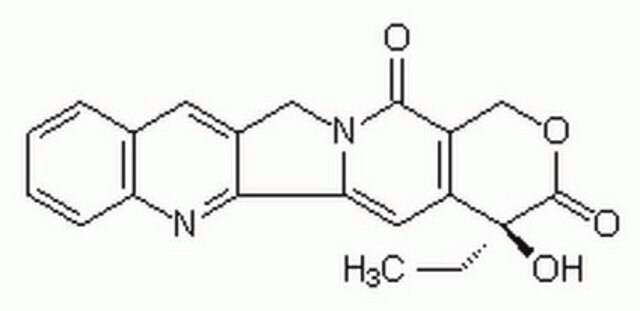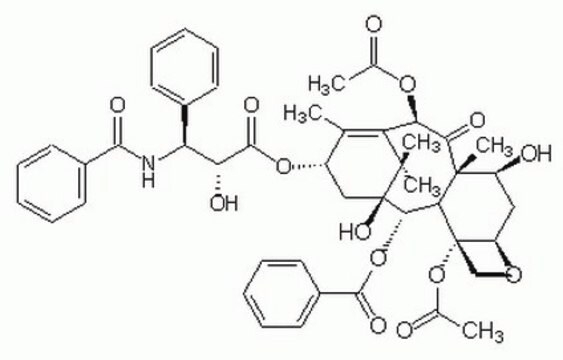APT800
Apoptosis Inducer Set
Apoptosis Inducer Set contains Actinomycin D, Camptothecin, Cycloheximide, Dexamethasone & Etoposide. These compounds can be used for inducing apoptotic activity in many cell culture systems.
Synonyme(s) :
5 Apotosis Inducers
About This Item
Produits recommandés
Niveau de qualité
Forme
liquid
Réactivité de l'espèce (prédite par homologie)
mammals
Fabricant/nom de marque
Chemicon®
Technique(s)
activity assay: suitable
Conditions d'expédition
dry ice
Description générale
Camptothecin: Powerful anti-tumor agent. Camptoethecin is an inhibitor of DNA-topoisomerase I. The drug activates the p53 resulting in upregulated expression of TRAIL-R2 (DR5) and Bak to overcome TRAIL resistance in Bax-deficient human colon carcinoma cancer cells. In addition, Camptoethecin induced apoptosis can be increased by the presence of cytokines such as TNF via its subsequent inhibition of NFkappa B {Valente P et al Eur J Cancer (2003) 39:1468-77}.
Cycloheximide: A potent protein translation inhibitor which results in the inhibition of protein synthesis and subsequent arrest of cell growth and induction of cell death. Cycloheximide also facilitates apoptosis induction via FasL, however, cycloheximide can also prevent apoptosis in some systems, such as thalassemic serum induction of HUVEC cells {Banjerdpong, R. (1998) Ph.D Thesis Mahidol Univ. Bangkok, Thailand}.
Dexaméthasone : Classic inducer of apoptosis in thymocytes; a glucocorticoid anti-inflammatory agent. Regulates T cell survival, growth and differientiation; modulator of nitric oxide synthase. Induces apoptosis in thymocytes as well as other immune cells like microglia. However, like other apoptotic inducers, dexamethasone can suppress apoptosis in certain systems through the activation of anti-apoptotic proteins such as bcl-X {Chang, et al (1997) FEBS Letter 415:11-15}.
Etoposide: Potent topoisomerase II inhibitor. & Inhibits the cell cycle in the S-phase and induces apoptosis in normal and tumor cell lines, but can be modulated by intracellular levels of cAMP and other factors {Bermejo, L et al (1998) J. Cell Sci 111:637-644;Solovyyan, V et al. (1998) Brain Res Mol Brain Res 62:43-55}
Application
Apoptose et cancer
Composants
·
·
·
· 100 μl
Forme physique
Stockage et stabilité
AVERTISSEMENT : Kit contains highly toxic agents; professional users only; wear gloves and other protective equipment and good laboratory practices when manipulating the concentrated and diluted solutions.
Informations légales
Clause de non-responsabilité
Mention d'avertissement
Danger
Mentions de danger
Conseils de prudence
Classification des risques
Acute Tox. 3 Oral - Aquatic Chronic 3 - Carc. 1B - Muta. 1B - Repr. 1B
Code de la classe de stockage
6.1C - Combustible acute toxic Cat.3 / toxic compounds or compounds which causing chronic effects
Point d'éclair (°F)
188.6 °F
Point d'éclair (°C)
87 °C
Certificats d'analyse (COA)
Recherchez un Certificats d'analyse (COA) en saisissant le numéro de lot du produit. Les numéros de lot figurent sur l'étiquette du produit après les mots "Lot" ou "Batch".
Déjà en possession de ce produit ?
Retrouvez la documentation relative aux produits que vous avez récemment achetés dans la Bibliothèque de documents.
Notre équipe de scientifiques dispose d'une expérience dans tous les secteurs de la recherche, notamment en sciences de la vie, science des matériaux, synthèse chimique, chromatographie, analyse et dans de nombreux autres domaines..
Contacter notre Service technique










